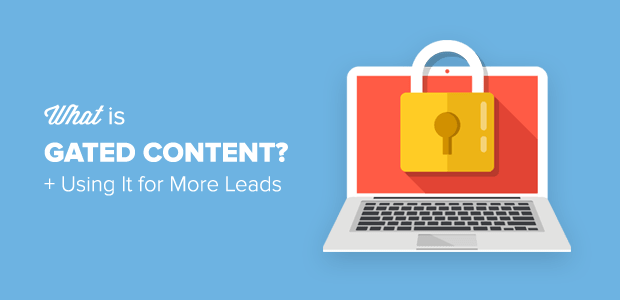Do you need help generating high-quality leads that convert? Have you tried every lead generation tactic in the book, only to feel frustrated and overwhelmed? Worry no more. Today’s blog post will unlock the secret to success by revealing how gated content can supercharge your lead-generation efforts.
Lead generation is the lifeblood of many businesses. One of the most effective ways to bolster your efforts in this arena is through gated content. Today, we will take a closer look at how this powerful strategy can supercharge your lead-generation efforts. Let’s dive in!
What is Gated Content?

Gated content requires users to provide their information, such as name, email, phone number, or business details before they can access it. This could be anything from a helpful blog post or a white paper to an instructional video or a webinar. By creating a “gate” around your valuable content, you have the power to generate more high-quality leads, nurturing them through the sales funnel toward conversion.
Why You Should Use Gated Content for Your Lead Generation
In the realm of online marketing, attention is a currency. However, more than getting your audience’s attention is required. You need to turn that attention into action. Gated content is a fantastic way to do this.
By using gated content, you transform passive content consumers into active leads. You provide them with high-value content; in exchange, they provide you with their contact information. This exchange sets the stage for further engagement, enabling you to nurture these leads through your sales funnel.
Benefits of Creating Gated Content
There are several benefits to creating gated content:
Lead Generation
Gated content acts as a lead magnet, drawing in prospective clients by offering valuable insights or information in return for their contact details.
Lead Qualification
You can qualify leads right from the start by asking for specific information. This allows you to focus your efforts on those most likely to convert.
Establishing Authority
Providing in-depth, high-value content helps to establish your business as a thought leader in your industry.
Creating a Database
Collecting contact information helps to build a database for email marketing and other outreach campaigns.
How to Optimize Your Gated Content
Optimizing your gated content ensures it reaches the right people and encourages them to take action. Here’s how:
Target the Right Audience
Ensure your content speaks directly to your ideal customer. Tailor it to their pain points and interests.
Create High-Quality Content
The value of your content is the main driving force for people to share their contact information. Make it worth their while.
Optimize Landing Pages
Keep landing pages clear and concise, with an easy-to-fill form and a compelling call to action.
Promote Your Content
Leverage SEO, social media, email marketing, and other channels to drive traffic to your content.
Examples of Types of Gated Content
You can create various types of gated content, depending on your audience and resources. Some examples include:
- E-Books and Guides: Comprehensive, in-depth resources on valuable topics to your target audience. These materials provide substantial information and insight, warranting the exchange of contact information.
- Whitepapers and Industry Reports: These are authoritative, detailed documents that delve into complex issues relevant to a specific industry. Whitepapers and industry reports often include research findings and actionable insights not readily available elsewhere.
- Webinars and Online Courses: These offer detailed instruction or educational material, often presented by an expert. Webinars and online courses can be live, allowing participants to ask questions and interact, or they can be recorded for convenience.
- Case Studies provide real-world examples of how your product or service has helped customers. Case studies can be very persuasive, as they offer potential leads a glimpse into the results they could achieve.
- Tools and Calculators: These interactive resources can help potential leads solve problems or answer questions. For example, a mortgage calculator for a real estate website or an ROI calculator for a marketing services site.
- Exclusive Videos or Podcasts: Video or audio content providing unique insights or entertainment can compel visitors to share their contact information.
- Newsletters or Subscription Services: Regularly delivered content, such as a weekly industry analysis, a monthly advice column, or daily news roundups, can also be a form of gated content.
Each type of gated content has its strengths, and the most effective choice depends on your audience’s preferences and business goals. Remember that the content must be valuable enough to make your audience willing to exchange their contact information.
Tips on Creating an Effective Gated Content Strategy
Creating an effective gated content strategy requires planning and ongoing evaluation. Here are some tips:
- Understand Your Audience: Knowing your target audience is crucial to developing content they will find valuable. Research their interests, pain points, preferences, and demographics to provide relevant and engaging content.
- Create High-Quality Content: Ensure the content behind the gate is genuinely valuable and high-quality. It should be in-depth, informative, well-researched, and directly relevant to your audience. The higher the quality, the more likely your audience will feel it’s worth giving their information.
- Determine What to Gate: Not all content should be gated. If your gate is too much, you might deter potential leads. On the other hand, gating low-value content can lead to disappointment and harm your credibility. Typically, more comprehensive, in-depth content like e-books, white papers, and webinars are the types that are gated.
- Promote Your Gated Content: Make sure your audience knows your gated content exists by promoting it through various channels. This could be through social media, email marketing, SEO, PPC ads, guest posting, or partnerships with other companies.
- Keep the Form Simple: Keep your lead capture forms as simple as possible to avoid discouraging potential leads. Ask only for the information you need. A name and email address are often enough to start the lead nurturing process.
- Test and Adjust: Like any marketing strategy, you should continuously test and adjust your gated content strategy based on results. Experiment with different types of gated content, promotion strategies, and form structures. Track the results and refine your strategy accordingly.
- Nurture Your Leads: The work is still ongoing once someone has provided their information to access your gated content. You must nurture these leads by providing them additional valuable content, keeping them engaged with your brand, and gradually guiding them through your sales funnel.
By following these tips, you can create an effective gated content strategy that helps to attract and convert more high-quality leads for your business.
Tools to Help You Create and Optimize Your Gated Content
Numerous tools can help with creating and optimizing your gated content. There are multiple tools available that can help you create, manage, and optimize your gated content strategy. Here are some examples:
Content Creation Tools
- Canva: A graphic design platform that allows you to create visual content such as infographics and social media graphics.
- Adobe Creative Cloud: A suite of design and multimedia tools for creating visually appealing content like eBooks and whitepapers.
Landing Page Builders
- Leadpages: A landing page builder that allows you to create beautiful, high-converting landing pages with built-in forms.
- Unbounce: Another landing page builder that offers A/B testing functionality to help optimize your pages for conversions.
Email Marketing Tools
- Mailchimp: An email marketing platform that allows you to automate email campaigns, which helps promote your gated content and nurture leads.
- ConvertKit: An email marketing tool built specifically for creators with features like a landing page and form builders, email automation, and more.
Marketing Automation Tools
- HubSpot: A comprehensive marketing automation platform that lets you create landing pages, forms, email marketing campaigns, and automated workflows, as well as offering CRM capabilities.
- Marketo: Another robust marketing automation tool that provides similar capabilities to HubSpot, helping you manage and automate your lead generation and nurturing process.
Analytics Tools
- Google Analytics: A web analytics tool that tracks and reports website traffic, allowing you to see how well your gated content performs and where your traffic is coming from.
- Hotjar: A behavior analytics tool that helps you understand how users interact with your website and landing pages, which can help optimize your gated content strategy.
SEO Tools
- SEMrush: A SEO tool that helps you perform keyword research, track keyword ranking, check backlinks, and complete a detailed SEO audit of your blog.
- Moz Pro: Another SEO tool offering similar capabilities, helping you to optimize your content to rank better in search engines.
Remember, the tools you choose should align with your needs and budget. Using these tools, you can create high-quality gated content, promote it to your target audience, and track your success.
Strategies for Tracking Results
You need to track results to understand if your gated content strategy is working. Monitor key metrics such as:
- Conversion Rates: The percentage of visitors who fill out your form.
- Lead Quality: Monitor the percentage of leads that turn into paying customers.
- Engagement: Measure how leads engage with your content after they’ve signed up.
Tools like Google Analytics and CRM platforms can help track these metrics.
Alternatives to Gated Content
Gated content is one of many ways to generate leads. Alternatives include:
- Ungated Content: This content is freely available and can still bring in leads through strong calls to action.
- Free Trials: Offering a free product or service trial can bring in leads.
- Content Upgrades: Offering extra content within a blog post in exchange for an email.
Measuring Your Success With Gated Content
Success looks different for every business. However, generally, the success of your gated content strategy could be measured by:
- Increase in the Number of Leads: More leads often mean more potential for conversions.
- Higher Quality Leads: If you’re attracting leads that convert at a higher rate, your strategy is likely thriving.
- Increased Engagement: Success can also be measured by how these leads interact with your brand after the initial sign-up.
By leveraging the power of gated content, you have the potential to supercharge your lead-generation efforts. Remember, it’s all about providing value and nurturing the relationship you build with your leads. So, why not get started today?
Start to Generate Leads with Gated Content
To wrap it up, incorporating gated content into your marketing strategy can be an incredibly effective to generate high-quality leads for your business. By providing value in exchange for contact information, you can build a robust list of potential customers and nurture them toward conversion. However, creating an effective gated content strategy requires careful planning, consistent execution, and regular optimization.
If you’re ready to supercharge your lead generation efforts with gated content but need a helping hand, don’t hesitate to contact Door Domination. With our expertise in crafting successful gated content strategies, we can help you transform your audience’s attention into actionable leads, fuelling your business’s growth. Contact us today, and let’s unlock your business’s potential together.



